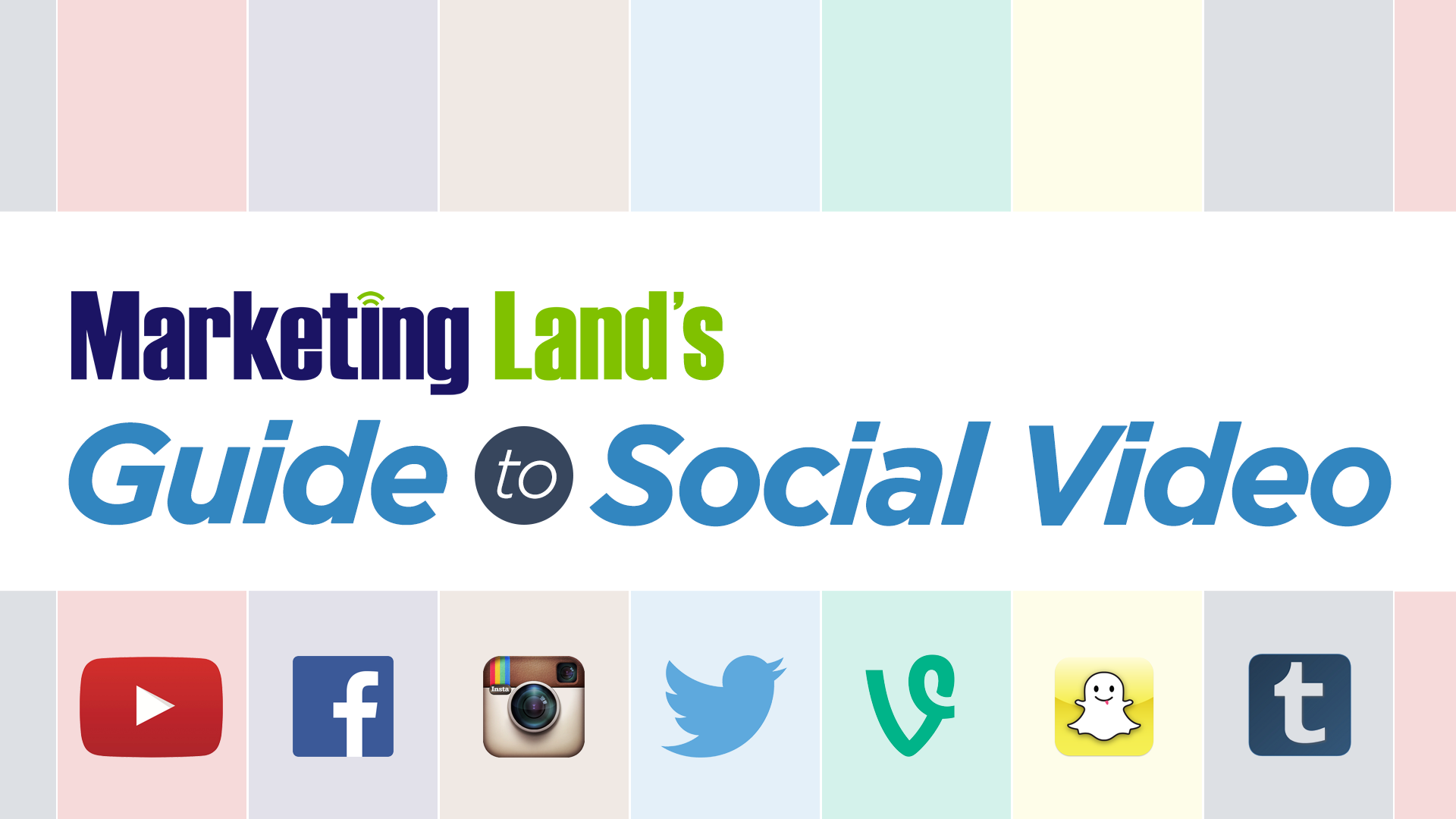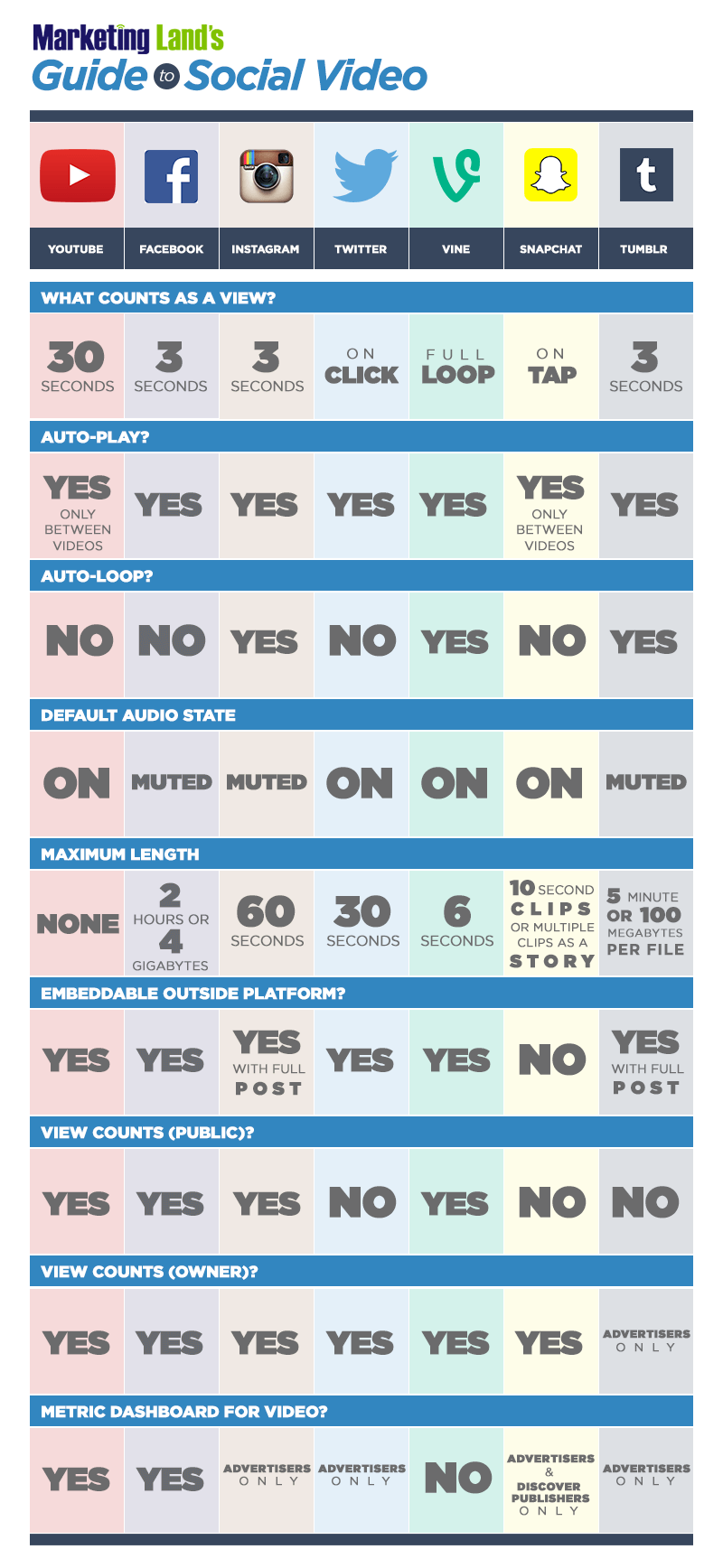Social Video Chart: Your at-a-glance guide to 7 major platforms
A side-by-side feature comparison of the seven major social video players -- YouTube, Facebook, Twitter, Instagram, Vine, Snapchat and Tumblr.
It used to be that if you were doing online video, you were doing YouTube, and probably nothing else.
Today, YouTube is still an enormously popular outlet for video marketers, but it’s no longer the only one around. Facebook is regularly touting the growth of video watching among its users, and the company has launched multiple new video products, like Live and 360. Instagram (owned by Facebook, of course) is also regularly pushing video content and ads. Twitter supports native video and owns both Periscope for live video streams and Vine for shorter clips. And no one should overlook Snapchat and Tumblr as video platforms.
Making matters complicated for video marketers is that different video platforms have unique features, requirements and metrics. Some offer auto-play video, some don’t. Some play videos with audio on by default, others don’t. Vine videos are limited to just six seconds, while YouTube videos don’t have a time limit.
How’s a video marketer supposed to keep track of it all?
Easy: with Marketing Land’s Social Video Chart, which we’ve embedded below. We’ve compiled the information directly from the platforms themselves; there’s no guesswork involved below. Our focus is on the social/video platforms that provide clip-based video sharing, not on live streaming platforms like Periscope, Hangouts and others. Each of the services we list allows brands to post video natively. All except for Vine offer brands the option to spend to promote videos. (Vine videos can, however, be promoted on Twitter.)
Without further ado, here’s Marketing Land’s Social Video Chart, last updated on May 4, 2016.
What’s changed?
Here’s a list of what has changed in this update.
What counts as a view?
Twitter changed from “3 seconds” to “on click.”
Auto-play?
YouTube changed from “yes” to “no.”
Default audio state
Twitter changed from “muted” to “on.”
Maximum length
- YouTube changed from “15 minutes; if verified, 11 hours” to “none.”
- Facebook changed from “40 minutes” to “2 hours or 4 gigabytes.”
- Instagram changed from “15 seconds” to “60 seconds.”
- Tumblr changed from “5-minute daily limit; no limit for an advertiser; 100 mb/file” to “5 minute or 100 megabytes per file.”
View counts public?
Instagram changed from “no” to “yes.”
View counts owner?
Instagram changed from “advertisers only” to “yes.”
Metric dashboard for video?
- Instagram changed from “no” to “advertisers only.”
- Snapchat changed from “no” to “advertisers and Discover publishers only.”
How to read the chart
Here’s our legend to what’s on the guide:
What counts as a view: If you thought watching an entire video is required for a view, you thought wrong. A view can be counted if someone watches only a few seconds of a video. For more, see our other stories about the issue: What’s A Video View? On Facebook, Only 3 Seconds Vs. 30 At YouTube and Do Video Views Matter? CMOs Weigh In On The Video Marketing Metrics That Count
Auto-play: Does the video play automatically or require someone to manually click or take an action? For video that auto-plays, it’s wise to create video with compelling imagery in the very first frames, since you are hoping for a click to activate the full video experience (and competing against other moving pictures in the feed).
Auto-loop: Does the video keep playing while a user remains on the post?
Default audio state: Does the video play sound automatically or not?
Maximum length: How long can your video masterpiece be? Keep in mind that if you’re trying to use the same video across multiple platforms, a lowest-common-denominator approach might be wise.
Embeddable: Can you share your video in a web page outside the platform itself?
View counts (public): Can the public tell how popular (or not) your video is, in terms of views?
View counts (owner): Can you tell how popular your video is? Usually, this is an option for advertisers in cases where view counts aren’t shown to the public.
Metric dashboard: Does the platform make it easy to have an overview of what’s happening with all your video content?
Thanks to marketing pro and spreadsheet wiz Andréa Lopez for providing inspiration and assistance for the original version of our Social Video Chart. Thanks also to former Marketing Land writer Martin Beck for research and writing on the original.
Opinions expressed in this article are those of the guest author and not necessarily MarTech. Staff authors are listed here.
Related stories

